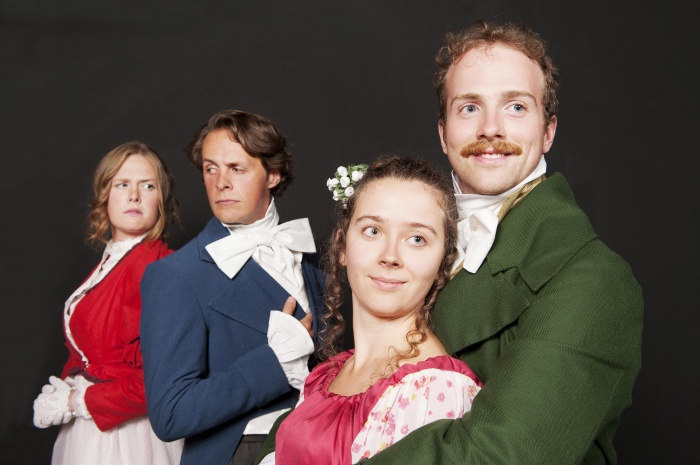Jane Austen’s Pride and Prejudice brings to the table nearly 200 years of baggage and tradition, not the least of which were my feelings after reading this novel as an 18-year-old English Lit student deep into Asimov and Heinlein. I was not a fan; “scorn” is not too strong a word. I’ve grown (I’d like to think) since then, and this play’s ads promise to make it “more accessible, fresher, and sparkling.” So, can this adaptation transform this archaic romance of landed gentry into a palatable play?

Short answer: yes. By all accounts, it’s well crafted, engaging, and joyful. Directed by Judy Trelor, Pride and Prejudice tells the story of the Bennett family, whose five daughters need to get married to secure their future, as the estate must legally pass to the closest male heir. An opportunity presents itself when two wealthy bachelors move into the estate next door. There are trials and tribulations, but Elizabeth, the lead character, and her favourite sister, Jane, both eventually find love and happiness in marriage.
The play, which is leisurely in its duration and pace, was admirably pushed forward by a strong set of performers. Each daughter was quickly given a separate personality. A restrained and aloof Mr. Bennett (Paul Terry) played a great foil to the abrasive, intrusive, and excitable Mrs. Bennett (Jennifer Hoener). The continual love-sick grin of Mr. Bingley (Ian Simms) managed to stay endearing the whole time, and Montgomery Björnson’s stiff portrayal of Mr. Darcy was restrained enough to be true to character, yet emotive enough to engage.
The absurdly foppish Mr. Collins (Chase Hiebert) stole a few scenes and certainly hit home the most humorous lines. The standout of the night, however, was Lizzie Bennett (Melissa Taylor). There was a composure and lightness to her performance that really let her wit and banter strike home without it feeling abusive or mean. She smoothly created an independent, confident, and brilliant woman without making her pretentious or nasty. The technical expertise in the seamless, rapid-fire delivery of elaborate sentences was also impressive.
The simple set made use of a clever rotating door to help differentiate locals, although I was a bit let down by the monochrome paint style: it seemed like an opportunity lost. The costumes were lavish, rich and time-period consistent. They were successful in rooting the action to the desired time frame. Again, though, there was a monochromatic theme to the daughter’s outfits that seemed broad and limiting.
Pride and Prejudice succeeds most when it’s being comedic. The performers displayed expert comic timing and squeezed every drop of humour out of the script. A hilarious set piece involving a botched dance routine with Mr. Collins and a number of great one-liners from Mrs. Bennett peppered throughout the show kept the audience laughing. If anything, the comedy was too successful: the more tender moments struggled with the momentum of the humour and were sometimes run over by it. There was never quite enough breathing room, never enough pause to let me feel anything besides levity. In particular, the condemnation of Lydia was tonally jarring.
Pride and Prejudice delivers to the audience a more fun, and more bubbly, version of the book. Cleverly cutting the dialogue to bring out Lizzie’s latent feminism and gloss over the “miniaturist” descriptions of place and class that permeate the novel, the product truly is one refreshed and polished for today.
If only my 18-year-old self had got to this first rather than the novel, I could have set aside my own prejudices long ago.
Pride and Prejudice
Until October 18
$19 and up, Langham Court Theatre
langhamtheatre.ca
